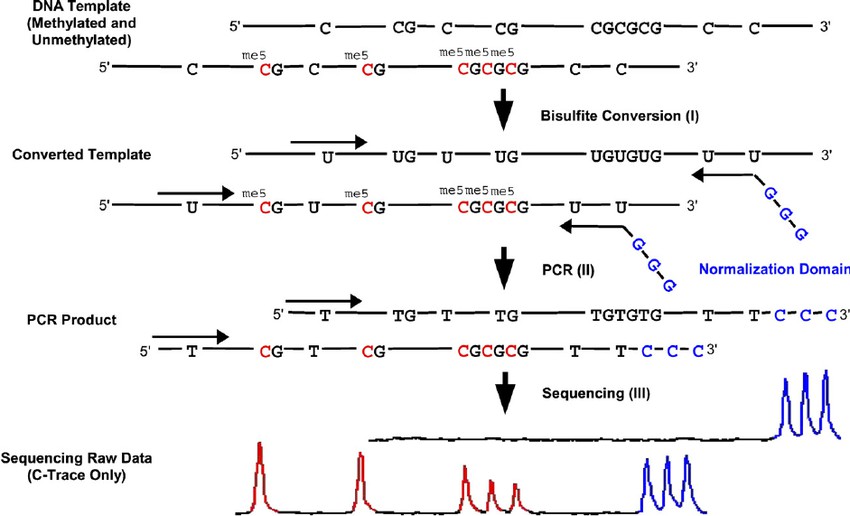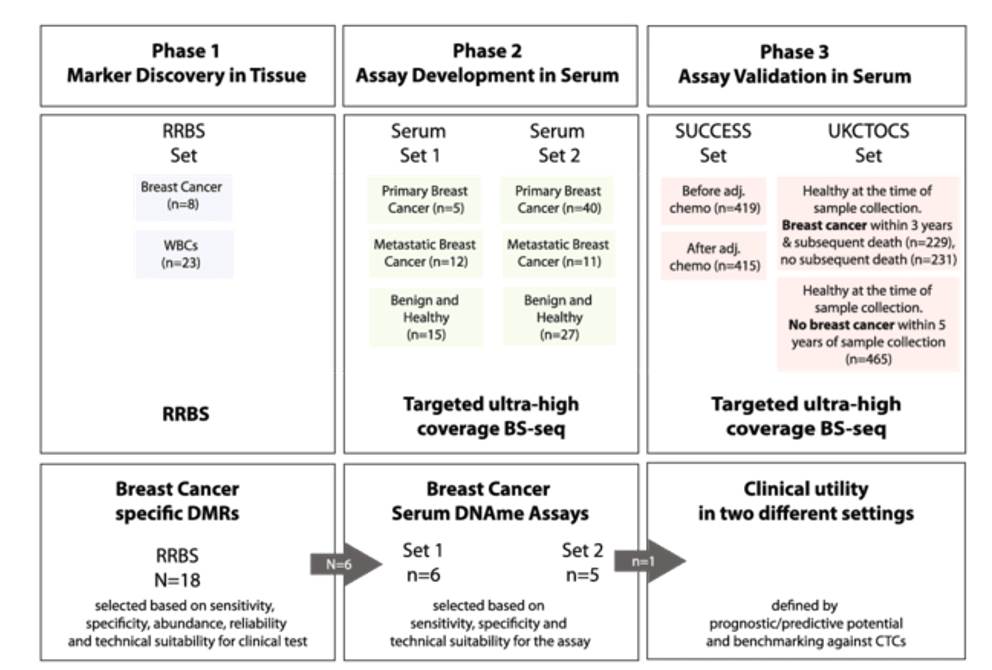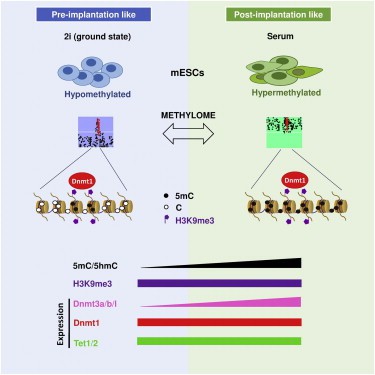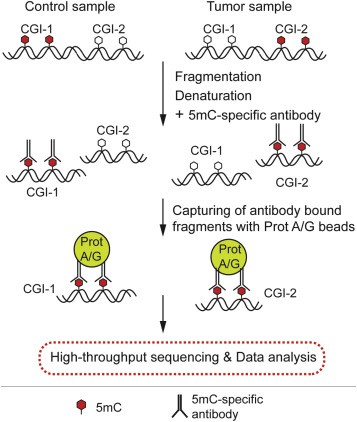DNA methylation is a pivotal mechanism regulating gene expression, characterized by the covalent attachment of a methyl group to the 5th carbon of cytosine at specific CpG dinucleotide sites mediated by DNA methyltransferases. This process plays a crucial role in DNA replication and transcriptional regulation, encompassing de novo methylation and maintenance methylation pathways. De novo methylation entails the methylation of previously unmethylated DNA strands catalyzed by methyltransferases, whereas maintenance methylation occurs when one strand of the DNA duplex is already methylated, leading to methylation of the unmethylated strand. These methylation modalities collectively maintain the stability and dynamic equilibrium of the methylome.
Principles of DNA Methylation
DNA methylation represents a extensively researched and longstanding epigenetic regulatory mechanism. Broadly, it refers to the chemical modification process where specific bases within the DNA sequence, under the catalytic action of DNA methyltransferases utilizing S-adenosyl methionine as the methyl donor, undergo covalent attachment of methyl groups. This modification can occur at various sites such as the C-5 position of cytosine, N-6 position of adenine, and G-7 position of guanine. In most contexts, It predominantly refers to the methylation process of the 5th carbon of cytosine in CpG dinucleotides. The resultant product, 5-methylcytosine, represents the primary form of DNA methylation in eukaryotes, including plants and animals, and constitutes the sole known form of DNA methylation in mammals. As a relatively stable modification state, DNA methylation can be inherited to offspring DNA during DNA replication via the action of DNA methyltransferases, thus constituting a crucial epigenetic mechanism.
Classification of DNA Methyltransferases
Within the genome, the establishment of DNA methylation patterns relies on the activity of DNA methyltransferases. These enzymes encompass maintenance DNA methyltransferases (also known as Dnmt1 or maintenance methyltransferases) and de novo methyltransferases. Based on sequence homology and function, eukaryotic DNA methyltransferases further subdivide into four classes: Dnmt1/MET1, Dnmt2, CMTs, and Dnmt3. Dnmt1/MET1 enzymes are responsible for maintaining the methylation status of CG sequences. CMTs enzymes are exclusively found in plants, characterized by their catalytic domains T and IV being buried within the chromosomal major area and their specific maintenance of CG sequence methylation. Dnmt3 enzymes have been identified in mice, humans, and zebrafish. Among these, Dnmt3a and Dnmt3b exhibit higher expression levels in undifferentiated embryonic stem cells but lower expression levels in somatic cells. Their primary function is de novo methylation, although they also contribute to maintenance methylation and are responsible for methylation of repetitive sequences.
Detection method of DNA methylation
1) Bisulfite Sequencing
Bisulfite sequencing, a widely employed method for DNA methylation analysis, entails the conversion of unmethylated cytosines to uracils via specific chemical reactions, generating uracil bands in the DNA sequence that are easily discernible. Methylated cytosines remain unaffected, retaining their original state. Subsequently, DNA fragments treated with bisulfite are selectively amplified through PCR. And their sequence information is acquired using DNA sequencing technology. By aligning the sequencing results with the original sequence, one can precisely enumerate the number and distribution of methylated sites, thereby assessing the degree of DNA methylation. This method is particularly suited for detecting methylation levels in individual genes or a limited set thereof.

Principle of the quantitative bisulfite sequencing method (Dimo Dietrich et al,.2019 )
2) RRBS
Reduced Representation Bisulfite Sequencing (RRBS) utilizes bisulfite treatment and restriction enzyme digestion to amplify DNA fragments enriched with high methylation content selectively. This method expedites the accurate detection of heavily methylated CpG sites within the genome.

Study design of Reduced representation bisulfite sequencing (RRBS) (Martin Widschwendter et al,. 2017)
3) WGBS
Whole Genome Bisulfite Sequencing (WGBS) represents a high-throughput approach capable of comprehensively assessing the methylation levels of every individual cytosine base throughout the entire genome. Achieving precise methylation data necessitates deep sequencing coverage with this method.

Whole-Genome Bisulfite Sequencing of DNA Methylomes of Mouse Embryonic Stem Cells (Ehsan Habibi et al,. 2013)
4) MeDIP-seq
Methylated DNA Immunoprecipitation Sequencing (MeDIP-seq) leverages immunoprecipitation with antibodies targeting 5-methylcytosine, succeeded by high-throughput sequencing. This methodology facilitates the comprehensive detection of methylation status across all CpG sites within the genome.

Methylated DNA immunoprecipitation sequencing (MeDIP-seq). (Tibor A. Rauch, Gerd P. Pfeifer, 2019
For more information about DNA Methylation Sequencing Methods, refer to “Overview of DNA Methylation Sequencing Methods”.
Applications of DNA methylation
Disease Pathogenesis
Within the realm of oncology, alterations in the methylation patterns of key tumor-associated genes orchestrate a cascade of events culminating in gene silencing or overexpression, thereby propelling tumorigenesis. Exemplifying this, in breast cancer, frequent DNA methylation events targeting tumor suppressor genes including BRCA1 and TP53 engender diminished or abrogated gene expression, thereby heightening susceptibility to malignancy. Furthermore, deviations in DNA methylation levels intricately correlate with tumor aggressiveness and prognostic outcomes. Investigations underscore that tissues exhibiting heightened methylation profiles typically manifest inferior survival rates and augmented metastatic propensities relative to counterparts evincing lower methylation levels. Consequently, It emerges as a pivotal entity in the landscape of early cancer detection and diagnosis.
Cardiovascular diseases like hypertension, coronary artery disease, and heart attacks are linked to disrupted DNA methylation and gene expression. Besides, DNA methylation aids in diagnosing inherited disorders, including monogenic conditions like cystic fibrosis and hemophilia.
Expanding the purview, emerging evidence implicates DNA methylation in the pathogenesis of psychiatric disorders, including autism spectrum disorder and schizophrenia. Furthermore, investigations suggest a potential nexus between DNA methylation patterns and autoimmune diseases. Such as rheumatoid arthritis and systemic lupus erythematosus, underscoring its multifaceted role in disease pathophysiology.
Exploring the Landscape of Disease Biomarkers
Within the realm of cancer research, DNA methylation emerges as a cornerstone, delineating distinct methylation signatures across diverse malignancies. Interrogating the DNA methylation landscape of neoplastic tissues facilitates early detection, prognostic evaluation, and recurrence surveillance. Noteworthy is the prognostic relevance of gene-specific methylation statuses in lung cancer, colorectal cancer, breast cancer, and other tumor types, elucidating survival probabilities and recurrence propensities.
In the domain of genetic diseases, DNA methylation assumes a diagnostic mantle. For example, By scrutinizing the methylation profiles of select genes, the identification and screening of monogenic inherited disorders, exemplified by cystic fibrosis and hemophilia, are streamlined.
Insights into the causes of psychiatric disorders like autism and schizophrenia are linked to the complex landscape of DNA methylation. Methylation analysis in psychiatric disorders enhances understanding of disease and opens new paths for diagnosis and treatment.
Expanding the purview to autoimmune diseases like rheumatoid arthritis and systemic lupus erythematosus, burgeoning research underscores the contributory role of DNA methylation. Besides, Evaluation of DNA methylation patterns among patients afflicted with autoimmune disorders augments our comprehension of disease mechanisms and unveils promising therapeutic strategies.
Breeding of Animals and Plants
In the realm of animal and plant breeding, research endeavors delve into the intricate interplay between methylation patterns and various phenotypic manifestations. it includes growth, development, disease resistance, reproductive prowess, embryonic maturation, and senescence. This fundamental exploration serves as a linchpin in understanding the genetic underpinnings of desired traits in both animal and plant species.
Using DNA methylation as a molecular marker gives breeders a powerful tool to identify individuals with desirable traits. For example, disease resistance, pest immunity, and increased productivity in animals and plants. This molecular marker augments precision breeding efforts aimed at enhancing agricultural productivity and sustainability.
Moreover, the advent of genome editing technologies revolutionizes breeding paradigms by facilitating the targeted modulation of methylation profiles within animal and plant genomes. This molecular manipulation engenders precise control over gene expression dynamics, thereby augmenting the manifestation of desired phenotypic traits in progeny.
Read More:
Where Does Biolife Get Their Money?
Environment
Delving into environmental considerations, the utilization of plants for remediation purposes emerges as a promising avenue. Certain botanical species exhibit a remarkable propensity for pollutant sequestration.
Microbial degradation stands as a cornerstone in the arsenal of environmental remediation strategies. Besides, Manipulating the methylation profiles of microbial consortia holds promise for enhancing their enzymatic prowess in metabolizing organic pollutants, thereby facilitating the bioremediation of contaminated ecosystems.



Attractive section of content. I just stumbled
upon your website and in accession capital to assert that I get in fact enjoyed account your blog
posts. Anyway I’ll be subscribing to your feeds and even I achievement you
access consistently rapidly.
Isotroin 20mg Capsule helps treat acne by decreasing the production of sebum (a pure substance) that causes acne. This kills acne-causing bacteria and prevents spots or pimples from showing. It normally takes a couple of weeks to have a noticeable effect so hold taking it even when it seems to not be working. Sometimes acne could worsen before it will get higher, however, with correct use, your skin will get clearer. This medicine will assist enhance your temper and uplift your confidence as your skin turns into acne-free.
dosage of hgh
References:
difference between testosterone and hgh – https://morphomics.science/wiki/wachstumshormone_Natrlich_steigern –
Um in diesem Sport bessere Leistungen zu erzielen, ist die Verwendung von hGH ein unbestreitbarer Vorteil.
Der Ruf des Wachstumshormons ist in diesem Bereich nicht zu übertreffen. Wenn Sie
sich auf unserer Website umsehen, werden Sie
einige Tipps zur Verwendung von hGH beim Rugby erhalten.
Es ist verantwortlich für eine ganze Reihe von Körperfunktionen, -mechanismen und
-prozessen wie Erholung, Reparatur von Zellgewebe, Regeneration, Kontrolle des Stoffwechsels und Wachstums.
Jahrhunderts versucht wurde, dieses natürlich vorkommende Hormon nachzuahmen. Bald
darauf wurde die erste synthetische Version des Hormons von Kabi Vitrum unter dem Handelsnamen „Somatropin” veröffentlicht.
Nicht nur, dass die Cortisolwerte auf Dauer ansteigen es wird auch die
Freisetzung von anderen Hormonen wie Testosteron und
HGH gehemmt. Idealerweile sollte man deshalb weitgehend
auf Zucker verzichten und stattdessen auf natürliche Süße wie Datteln, Bananen oder Rosinen greifen. Diese haben eineVielzahl an wichtigen Nährstoffen und viele Ballaststoffe welche die Verdauung fördern und
sich positiv den Insulin Spiegel auswirken. Zudem wirken sich diese nicht nur negativ
auf unsere Produktion auf Wachstumshormone aus sondern sind schädlich für unsere allgemeine Gesundheit.
Es gibt natürlich auch Lebensmittel die wichtige Nährstoffe
wie L-Arginin und GABA enhalten bz.
Sofern kein signifikanter dauerhafter Mangel an Wachstumshormonen vorliegt, besteht aus medizinischer Sicht kein Grund dazu, auf eine entsprechende Therapie
zu pochen. Um deinen HGH-Spiegel additionally
dennoch optimieren zu können, ohne dabei auf die hierzulande illegale Hilfe der Chemie
zurückgreifen zu müssen, stehen dir prinzipiell zwei Wege zur Auswahl.
Erstens, hartes Krafttraining und zweitens, eine
ausreichende Menge an Schlaf. Dass durch hartes Coaching vermehrt Wachstumshormone ausgeschüttet werden belegen sogar zahlreiche Studien renommierter Universitäten.
Dabei kommt es zu einem unnatürlichen Größenwachstum von Zunge, Kinn, Nase, Ohren,
Füßen und Händen. Diese pathologischen Veränderungen gelten bei voller Ausprägung als irreversibel.
Bei einer operativen Entfernung der Hirnanhangsdrüse
ist die lebenslange Substitution von Hypophysenhormonen erforderlich.
Die Ausbildung und Differenzierung von Organfunktionszellen der
Knochen und Muskulatur wären ohne die Wirkung des Wachstumshormons nicht möglich.
Die 24-Stunden-Pulsrate des Wachstumshormons wurde zufällig und häufiger während
dieser wachen Stunden. Diese Studie legt nahe, dass Schlafentzug die Wachstumshormonausschüttung am
nächsten Morgen reduzieren und den Schlaf-Wach-Zyklus empfindlich stören und verändern kann.
Der Großteil der pulsierenden Sekretion von Wachstumshormonen findet kurz nach Beginn des Schlafes
statt und steigt weiter an, wenn die ersten Stunden des Schlafes erreicht sind.
Das Ergebnis struggle, dass sich die kognitive Funktion und
die Stimmung nach sechsmonatiger Therapie anhand
von Stimmungsskalen signifikant verbesserten.
Durch die vermehrte Einlagerung von Wasser steigt der Blutdruck und die
Belastung des Herz-Kreislauf-Systems nimmt zu. Erythropoietin ist für die Produktion und den Haushalt der roten Blutkörperchen (Erythrozyten) zuständig.
Stellt der Körper eine mangelnde Sauerstoffversorgung
fest, so wird in der Niere EPO gebildet. Dieses regt die Bildung von roten Blutkörperchen in den Produktionsstätten im Knochenmark an. Es gibt numerous
Möglichkeiten seinen Wachstumshormonspiegel auf unterschiedliche Arten zu steigern, sodass der Wert
auf einem normalen Level verbleibt. Entweder es geschieht
durch die oben beschriebenen Lebensmittel, durch erwähnte Nahrungsergänzungsmittel und/oder durch Schlaf, intensives Coaching and so
forth.
Hierzu gehören unter anderem die Insulinresistenz und ein Mangel an Wachstumshormonen. Unter einer Insulinresistenz versteht man das fehlende Ansprechen der
Zielzellen auf das Insulin. Bei einem manifesten Wachstumshormonmangel bringt eine Therapie durch medikamentöse Verabreichung des Hormons in den meisten Fällen eine deutliche Verbesserung der Beschwerden. Der Wachstumshormon-Mangel des Erwachsenen ist seit
etwa 15 Jahren ein definiertes und anerkanntes klinisches Krankheitsbild.
Danach nimmt die körpereigene Produktion mit steigendem Alter kontinuierlich ab.
Die Hypophyse – eine etwa kirschkerngroße Drüse an der Schädelbasis – schüttet dabei unter anderem das Wachstumshormon HGH aus.
Das Wachstumshormon besteht aus 191 Aminosäuren und zirkuliert über die Blutbahn durch den Körper.
In besonders hohem Masse werden Wachstumshormone von Profibodybuildern eingesetzt,
welche als Vorbilder für zahlreiche Fitnesssportler dienen. Dadurch und weil hGH ohne grossen Aufwand im Web
beschafft werden kann, hat es Einzug in den Breitensport gehalten. Neuere Studien weisen nach, dass Wachstumshormone eine leistungssteigernde Wirkung auf die Schnellkraft von Sprintern haben. Wachstumshormone haben zudem in allen Kraft- und Ausdauersportarten ein grosses Potenzial für Missbrauch.
References:
aparca.app
how to take dianabol first cycle
References:
dianabol and deca cycle (csmouse.com)
hgh injections side effects
References:
hgh Dosage For bodybuilding
hgh vorher nachher
References:
hgh 4iu per day results bodybuilding
strongest legal steroid
References:
Buying illegal Steroids online – gitlab.rails365.net –